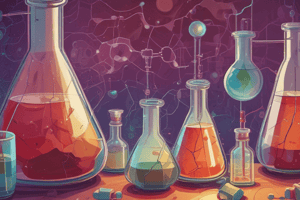Podcast
Questions and Answers
What is the first step in the analytical process?
What is the first step in the analytical process?
- Define the problem (correct)
- Prepare the sample for analysis
- Select a method
- Obtain a representative sample
What is the term for the process of collecting a small mass of material?
What is the term for the process of collecting a small mass of material?
- Analysis
- Sampling (correct)
- Measurement
- Preparation
What is the difference between accuracy and precision?
What is the difference between accuracy and precision?
- Accuracy is how close to each other, precision is how close to the true value
- Accuracy is how close to the true value, precision is how close to each other (correct)
- Accuracy is a measure of systematic error, precision is a measure of random error
- Accuracy is a measure of random error, precision is a measure of systematic error
What is the unit of the numerator in molarity?
What is the unit of the numerator in molarity?
What type of error occurs when something is intrinsically wrong in the measurement?
What type of error occurs when something is intrinsically wrong in the measurement?
What is the formula for relative error?
What is the formula for relative error?
What is the unit of the denominator in molality?
What is the unit of the denominator in molality?
What is the percentage of sodium hydroxide in a solution if 25g of sodium hydroxide is dissolved in 100g of solution?
What is the percentage of sodium hydroxide in a solution if 25g of sodium hydroxide is dissolved in 100g of solution?
What is the strategy for converting between concentration units?
What is the strategy for converting between concentration units?
What is the volume of hydrochloric acid in a solution if it is 75% by volume?
What is the volume of hydrochloric acid in a solution if it is 75% by volume?
What is the concentration of a 35% w/v HCl solution?
What is the concentration of a 35% w/v HCl solution?
Which of the following concentration units is temperature-independent?
Which of the following concentration units is temperature-independent?
What is the minimum amount of energy required for a chemical reaction to occur?
What is the minimum amount of energy required for a chemical reaction to occur?
What is the term for the process where a solution contains more of the dissolved salt than it can hold?
What is the term for the process where a solution contains more of the dissolved salt than it can hold?
What is the principle that states that a chemical reaction will shift in a direction to counteract any changes made to the system?
What is the principle that states that a chemical reaction will shift in a direction to counteract any changes made to the system?
What is the term for the highest potential energy point in a chemical reaction?
What is the term for the highest potential energy point in a chemical reaction?
What is the process called when a precipitate is contaminated by other substances during its formation?
What is the process called when a precipitate is contaminated by other substances during its formation?
What is the type of reaction that occurs only with the substance of interest?
What is the type of reaction that occurs only with the substance of interest?
Flashcards are hidden until you start studying
Study Notes
Analytical Process and Measurement Concepts
- The first step in the analytical process is defining the problem or question to be resolved, setting the framework for investigation.
- The process of collecting a small mass of material is referred to as sampling, crucial for representative analysis.
- Accuracy refers to how close a measured value is to the true value, whereas precision reflects the reproducibility of measurements, regardless of their closeness to the true value.
Concentration Units and Solutions
- The unit of the numerator in molarity is moles, signifying the amount of solute in a given volume of solution.
- The unit of the denominator in molality is kilograms of solvent, representing the mass of the solvent in which the solute is dissolved.
- To calculate the percentage of sodium hydroxide in a solution where 25g sodium hydroxide is dissolved in 100g of solution, use the formula: (mass of solute/mass of solution) x 100, resulting in 25%.
Conversion and Concentration Calculations
- A strategy for converting between concentration units often involves using conversion factors that relate moles, volume, and mass.
- For a hydrochloric acid solution that is 75% by volume, the volume of hydrochloric acid can be determined based on the total volume of the solution.
- The concentration of a 35% w/v (weight/volume) HCl solution would be calculated as grams of HCl per 100 mL of solution, yielding concentration data for practical applications.
Chemical Reaction Principles
- A temperature-independent concentration unit is molality, which is defined by the amount of solute in relation to the mass of the solvent.
- The minimum amount of energy required for a chemical reaction to occur is known as the activation energy, a key concept in thermodynamics.
- A solution that contains more dissolved salt than it can hold is termed supersaturated, indicative of dynamic balance in solutions.
- Le Chatelier's principle states that a chemical reaction will adjust in response to changes in concentration, temperature, or pressure to restore equilibrium.
Energy and Reaction Mechanisms
- The term for the highest potential energy point in a chemical reaction is the transition state, representing a critical moment in the transformation of reactants to products.
- The process where a precipitate becomes contaminated by other substances during its formation is known as coprecipitation, affecting purity and outcome.
- A reaction that occurs only with the substance of interest is known as a selective reaction, emphasizing specificity in chemical processes.
Studying That Suits You
Use AI to generate personalized quizzes and flashcards to suit your learning preferences.




